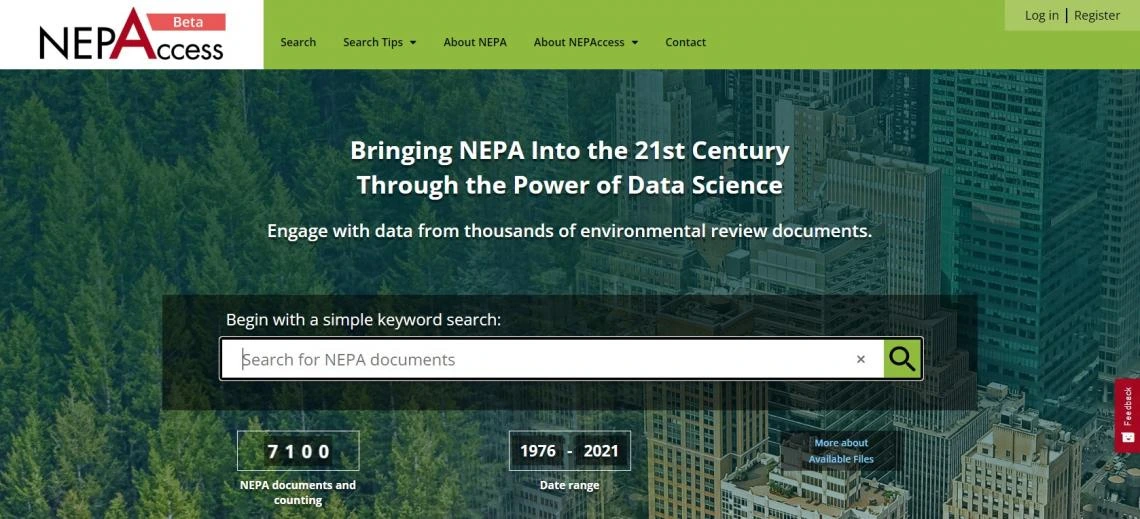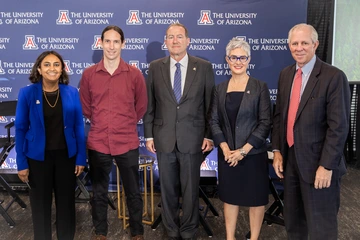Inspired by Data Science, Team Aims to Fulfill the Promise of NEPA Environmental Goals
NEPAccess harnesses the power of today’s data science to realize the original vision and intent of NEPA.

During the 1960s, a series of environmental catastrophes and revelatory books transformed the American environmental consciousness, setting the stage for the passage of the National Environmental Policy Act (NEPA) in 1969. More than fifty years later, a group of researchers at the University of Arizona is helping to bring NEPA’s original vision into the 21st century through advanced data science practices, galvanizing a new generation of environmental leaders.
NEPA broke new ground as the first major federal legislative effort to incorporate environmental considerations into all government decision-making. The Act required agencies to prepare Environmental Impact Statements (EIS) for all major federal actions — for example, highway projects, mines, dams, and power plants — significantly affecting the environment and established the White House Council on Environmental Quality to compile information on environmental conditions and trends.
NEPA has generated vast amounts of data on federal projects and environmental conditions across the US. But this information has been prohibitively difficult to access, with no centralized repository of documents, no standard protocol for reporting analyses and data, and no central platform or standard approach for engaging the public.
The Data Science Revolution
Until now, the lack of systematic data on NEPA’s performance has hindered decision-makers and public participation, but today’s technologies and methods, unimaginable in 1969, now enable NEPA’s full vision to be implemented.
The NEPAccess project at the University of Arizona uses data science to help fulfill the Act’s original vision by making it possible for all citizens to participate in environmental governance. The platform uses machine learning and natural language processing approaches to unlock information from decades of past NEPA reviews and allows anyone to search, download, and analyze thousands of documents, from Notices of Intent through the final Records of Decision on federal actions.
The project was first conceived by professor Laura López-Hoffman, an environmental scientist with the UA School of Natural Resources and the Environment (SNRE) and the Udall Center for Studies in Public Policy, and Marc Miller, dean of University of Arizona Law, as they struggled to investigate the impacts of NEPA on public lands in the western United States. In an effort to address these limitations, the two began assembling a team of collaborators spanning data science, business, user experience design, environmental science, environmental policy, law, and public engagement. The UA team also includes Steven Bethard (iSchool), Kirk Emerson (School of Government and Public Policy), Aaron Lien (SNRE), and Sudha Ram (Eller College of Management). Just as critically, 24 undergraduates (and counting) from a variety of disciplines have assisted the NEPAccess project since its inception by finding and cataloging EIS documents, and manually categorizing and labeling documents to train the machine learning algorithms. Their participation has been fundamental to the progress and development of the project.
Bringing NEPA into the 21st Century

From left: Sudha Ram, Steven Bethard, Marc Miller, Laura López-Hoffman, and University President Robert C. Robbins.
Initial seed funding of $1.5M over three years from the National Science Foundation allowed work to begin on the project in 2018. In 2021, NEPAccess.org Beta went live, and the team began presenting the platform to agencies and the public—soliciting feedback, providing training, and identifying new stakeholders, data needs, and innovative ways to empower users.
In September 2021, NEPAccess was highlighted as part of a week-long series celebrating the opening of the University of Arizona Washington, D.C. Center for Outreach & Collaboration. The event was hosted by University of Arizona President Robert C. Robbins and included opening remarks from the Chair of the White House Council on Environmental Quality, Brenda Mallory, a demonstration of the platform, and breakout sessions led by the NEPAccess undergraduate researchers.
“One of the things that the Council on Environmental Quality does is to administer and implement the National Environmental Policy Act program, so NEPAccess is huge for us,” remarked CEQ Chair Mallory during the event. “The work that’s being done here is going to be very important in helping with NEPA document reviews and helping agencies to be able to take advantage of what has been done in the past in order to tap into that as we think about future activities.”
The Future of NEPAccess
The NEPAccess team has ambitious goals for the next three to five years, and beyond.
As additional funding opportunities permit, the team plans to expand the repository to include pre-2000 EISs and Environmental Assessments as well as going outside of NEPA documentation to collect scientific literature, project reports, mitigation and monitoring reports, news articles, and social media about outcomes of past NEPA projects. The team will use graph and network analyses and deep learning to develop dashboards and map-based interfaces for users to analyze and display results about the outcomes of NEPA processes and decisions.
The project also hopes to strengthen the public’s voice within the NEPA process by incorporating machine learning tools for analyzing formal and informal public comments, including social and news media.
The final phase will culminate in the NEPA 2.0 Workspace, a realization of the original vision for NEPA as a dynamic process for citizens, Tribal governments, and federal agencies to work together for the betterment of the environment.
